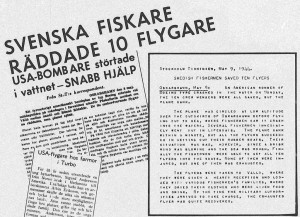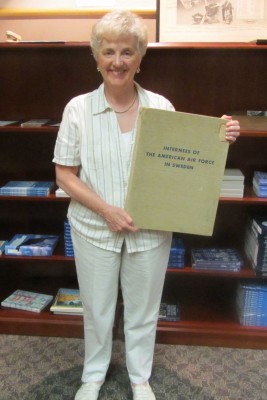17 Jul Air Force Historical Research Agency

Just one article from the Internee Book … Swedish news and English translation
Last week I made my second trip to the Air Force Historical Research Agency at Maxwell Air Force Base in Montgomery, Alabama. This is where historical documents of the Air Force are stored, over seventy million pages.
Just like the National Archives, you need to be prepared before you go. My main suggestions are:
(1) Contact the Visit Coordinator before you visit. When you walk into the Maxwell Visitor’s Center, unless you have military or retired civilian status, you need to have a sponsor before they will let you in. As the gentleman in uniform politely explained to me, “We don’t let just anyone on base, you know.” Thankfully, I had made an appointment ahead of time.
(2) Do your online research. You can search through an index of 550,000 of their documents here. I did this and printed off the pages of documents I wanted to see. Once I got to the facility, the young man who helped me advised that I prioritize them. Immediately, it was obvious that I had too many for one day of research. He showed me how to write down the Call Number, the Iris Number, and the Begin/Ending or Publish date for each item. One form holds 10 entries. You want to be ready to turn in your first order right away because it will take 30 to 45 minutes for your first dolly of boxes to arrive.
If you can’t get to Montgomery, you can make archival requests. I have found everyone there to be extremely helpful.

Holding my big find of the day. Someone said it was like finding a time capsule!
(3) Bring your laptop, scanner and camera. They also have a copy machine. The first time I visited the AFHRA I looked at some microfilm, but it was too difficult. I had enough to search through with the hard copy papers.
What you will get is pretty much in the same condition as these files were during World War II. Some of them were difficult, almost impossible, to scan. A good camera with a tripod might have worked better in a few cases.
Pack your lunch. There is an area where you can sit and eat with some vending machines for snacks if you are starving.
Personally, I had a wonderful day. I could spend a week, for sure. The one document I most wanted was there, and surprise … it was a large, professionally bound book! “Internees of the American Air Force in Sweden.” It is a history of the American internees, put together by Captain Robert L. Robb, Assistant to the Military Air Attache in Stockholm during WWII.
There were photographs, newspaper articles in Swedish, translated to English, and a “General Report on Swedish Internment.” Most of the stories were interesting and fun, but also a few described the airmen who died when their planes force-landed on Swedish soil. The Swedes and the Americans worked together to have a funeral service for our fallen boys, and many locals attended and paid their respects.


No Comments